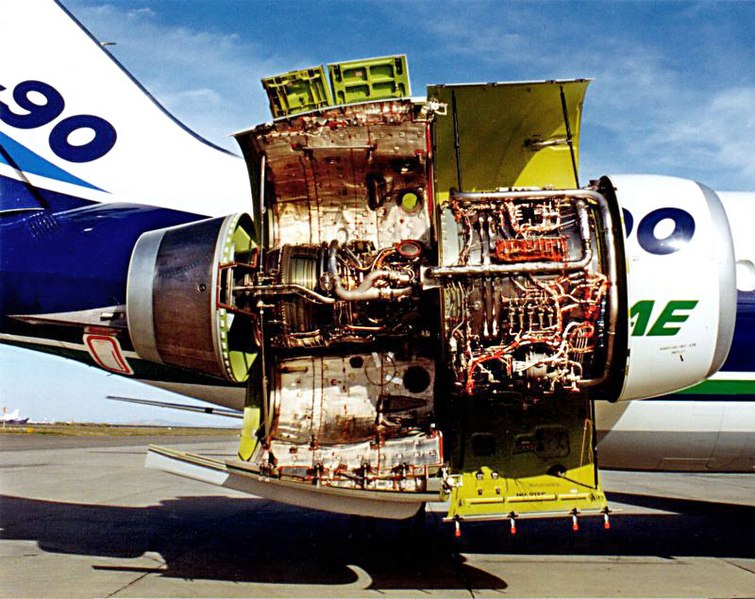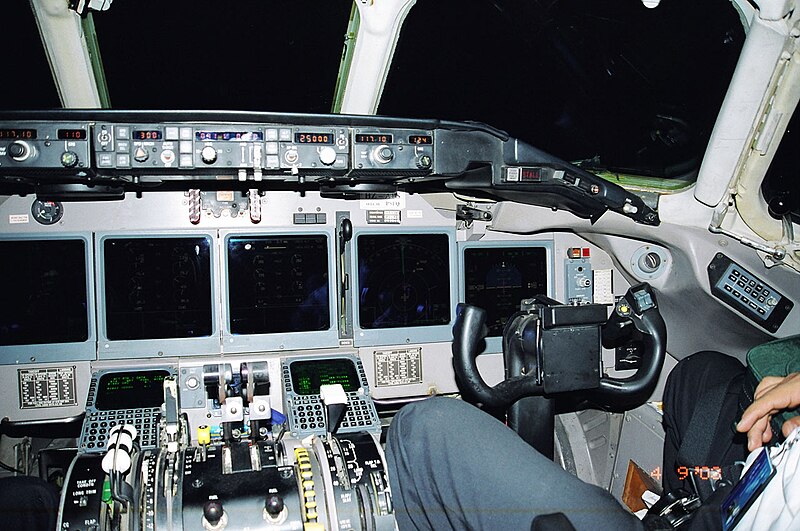Airplanes24.net
The Aviation Portal
The McDonnell Douglas MD-90 is a twin-engine, short- to medium-range, single-aisle commercial jet aircraft. The MD-90 was developed from the MD-80 series. Differences from the MD-80 include more fuel efficient International Aero Engines V2500 engines and a longer fuselage. The MD-90 has a seating capacity of up to 172 passengers and was introduced into service with Delta Air Lines in 1995.
The MD-90 and the subsequent MD-95/Boeing 717 were derivatives of the MD-80 which, itself, was a derivative commercially introduced in 1980 from the DC-9.
Design and development
Background
The Douglas Aircraft Company developed the DC-9 in the 1960s as a short-range companion to their larger DC-8. The DC-9 was an all-new design, using two rear fuselage-mounted turbofan engines, and a T-tail. The DC-9 has a narrow-body fuselage design with a 5-abreast seating with a capacity of 80 to 135 passengers depending on seating arrangement and aircraft version.
The second generation of the DC-9 was originally called the DC-9-80 series or the DC-9 Super 80 but later marketed as the MD-80 and entered service in 1980. McDonnell Douglas began studies into shorter derivatives of the MD-80 in 1983, these studies eventually becoming known as the MD-90. While for several years, McDonnell Douglas proposed powering the MD-90 with two propfan engines, by 1989, it was clear that there was insufficient interest in propjet powered aircraft, and reworked their proposals to feature the IAE V2500 turbofan instead.
MD-90
The MD-90 was firmly launched on November 14, 1989, when Delta Air Lines placed an order for 50 MD-90s, with options for a further 110 aircraft. The aircraft first flew on February 22, 1993 and the first MD-90 was delivered to Delta in February 1995. The MD-90 was produced adjacent to the Long Beach Airport in Long Beach, California, USA, though two aircraft were produced at Jiangwan Airfield in Shanghai, People's Republic of China.
The MD-90 is a mid-size, medium-range airliner that was developed from the MD-80 series. It is a 5 feet (1.5 m) longer, updated version of the MD-88 with similar electronic flight instrument system (EFIS) and more powerful, quieter and fuel efficient IAE V2500 engines instead of the JT8D engines, which power the MD-80 series. Typical seating for the MD-90 ranges from 153 to 172 passengers, depending on the cabin configuration and interior layout.
The MD-90 was produced in two versions: -30 and -30ER. The -30 has a range of 2,400 miles (3,860 km). The -30ER has a higher gross weight and range up to 2,750 miles (4,426 km) with an auxiliary fuel tank. An even longer range version, the -50, was offered but was never ordered.
The initial MD-90s feature a glass cockpit similar to the MD-88's cockpit. The 29 MD-90s delivered to Saudi Arabian Airlines feature a full glass cockpit with avionics and an overhead display panel similar to the MD-11's cockpit for easy transition for the airline's pilots of the MD-11, also operated by the airline.
No MD-90 orders were received after Boeing and McDonnell Douglas merged in 1997 due to internal competition with Boeing's 737. Delta Air Lines had initially placed a large order for the MD-90 to replace some aging Boeing 727s. After the Boeing-McDonnell Douglas merger, Delta canceled their remaining 19 MD-90 orders in favor of the Boeing 737-800. A total of 40 MD-90s (later 20) were to be assembled under contract in Shanghai, People's Republic of China under the Trunkliner program, but Boeing's decision to phase out the MD-90 resulted in only two built by Shanghai Aircraft.
MD-90 production at Long Beach, California ended in 2000 with the last airplane being delivered to Saudi Arabian Airlines, and MD-90T production at Shanghai ended in 2000. With 116 MD-90 aircraft produced, the MD-90 production run was the smallest among the DC-9 family.
Following the MD-90 in the DC-9 family was the MD-95, which was renamed the Boeing 717-200 after McDonnell Douglas (successor to Douglas Aircraft Company) merged with Boeing in 1997. The main competitors of the MD-90 included the Airbus A320 and the Boeing 737-800.
Variants
- MD-90-30
- Basic variant with two V2500 engines and an EFIS cockpit.
- MD-90-30IGW
- Increased Gross Weight version, one built.
- MD-90-30ER
- Extended Range (ER) version of MD-90-30, two built.
- MD-90-30T "Trunkliner"
- Variant of the MD-90-30 assembled by Shanghai Aviation Industrial Corporation in the People's Republic of China. Production was initially planned to be 40, later reduced to 20, with only two built in the end. To accommodate the heavy aircraft on unsuitable runways, a dual tandem landing gear with more tires to spread the weight of the aircraft was designed for the Trunkliner, but ultimately not used in the two aircraft produced.The COMAC ARJ21 is built using tooling retained by the Chinese after the end of the Chinese MD-90-30 program.
Operators
Major airlines that have operated the MD-90 include Delta Air Lines, Saudi Arabian Airlines, Japan Airlines, and Scandinavian Airlines. A total of 66 MD-90 aircraft (all variants) were in airline service in July 2012.
 Delta Air Lines (51)
Delta Air Lines (51) Japan Airlines (6)
Japan Airlines (6) Uni Air (6)
Uni Air (6) EVA Air (5)
EVA Air (5) Saudia (1)
Saudia (1)
Former operators (partial list)
 Blue1 (5)
Blue1 (5) Lion Air (5)
Lion Air (5) Japan Air System (16)
Japan Air System (16)

 Scandinavian Airlines (8)
Scandinavian Airlines (8)
Deliveries
| Type | Total | 2000 | 1999 | 1998 | 1997 | 1996 | 1995 |
|---|---|---|---|---|---|---|---|
| MD-90-30 | 113 | 3 | 13 | 34 | 25 | 25 | 13 |
| MD-90-30ER | 1 | 1 | |||||
| MD-90-30T | 2 | 2 | |||||
| Total | 116 | 5 | 13 | 34 | 26 | 25 | 13 |
Incidents and accidents
As of August 2010, the MD-90 has been involved in three incidents, including one hull-loss accident, with 1 fatality.
- Notable accidents and incidents
- On August 24, 1999 an UNI Air MD-90 caught fire after a passenger's carry-on luggage containing gasoline was ignited by a motorcycle battery contained in another passenger's carry-on luggage. One person was killed and 28 injured as a result of the cabin fire. The airliner was damaged beyond economic repair.
Specifications
| MD-90-30 | MD-90-30ER | |
|---|---|---|
| Passengers | 153 (2 class) 172 (1 class) |
|
| Max Take-off Weight | 156,000 lb (70,760 kg) |
168,000 lb (76,204 kg) |
| Take off run at MTOW | 7450 ft (2,270 m) | |
| Range | 2,085 nmi (3,860 km) | 2,172 nmi (4,023 km) *2,389 nmi (4,424 km) |
| Cruise Speed, typical | Mach 0.76 (504 mph, 811 km/h) | |
| Length | 152 ft 7 in (46.5 m) |
|
| Wing span | 107 ft 10 in (32.87 m) |
|
| Height | 30 ft 6 in (9.4 m) |
|
| Power plant (2 x) | IAE V2525-D5 25,000 lbf (111.21 kN) Optional: IAE V2528-D5 28,000 lbf (124.55 kN) |
|
Note: * With extra 565 gallon auxiliary fuel tank.
Source
http://en.wikipedia.org/wiki/McDonnell_Douglas_MD-90





